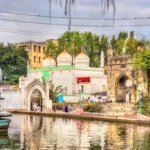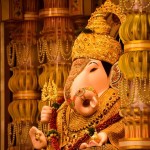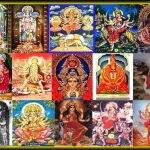Ganesh Visarjan: A heartfelt farewell to Lord Ganesha, symbolizing the cycle of life and unity in celebration.
Introduction
India, a land of diverse cultures and traditions, celebrates numerous festivals throughout the year. Among these, Ganesh Chaturthi stands as one of the most beloved and grandly celebrated festivals. It is a ten-day festival that culminates with the spectacular Ganesh Visarjan, where devotees bid adieu to their beloved Lord Ganesha. In this blog, we will delve into the significance of Ganesh Visarjan and the rituals associated with this emotional farewell.
Ganesh Chaturthi: The Arrival of Lord Ganesha
Ganesh Chaturthi, also known as Vinayaka Chaturthi, marks the birth of Lord Ganesha, the elephant-headed god of wisdom and prosperity. The festival usually falls in the Hindu month of Bhadrapada (August or September). Devotees prepare for this grand celebration weeks in advance, sculpting and decorating clay idols of Lord Ganesha.
The Arrival of Ganesh Idols: On the first day of Ganesh Chaturthi, devotees bring the beautifully crafted idols of Lord Ganesha into their homes or community pandals with great enthusiasm and reverence. The idol installation is a ceremonious affair, accompanied by Vedic chants and prayers.
The Ten-Day Celebrations: Over the next ten days, devotees perform aarti (rituals with lamps) and offer a variety of sweets and dishes as prasad (offering) to Lord Ganesha. These days are filled with cultural events, bhajans (devotional songs), and community gatherings.
Ganesh Visarjan: The Farewell
The culmination of Ganesh Chaturthi is the Ganesh Visarjan, which typically occurs on the 11th day of the festival, known as Anant Chaturdashi. During this emotional farewell, devotees immerse the idol of Lord Ganesha in a water body, symbolizing his return to his heavenly abode. This process is accompanied by elaborate rituals and fervent devotion.
Rituals of Ganesh Visarjan:
Uttarpuja: Before immersion, a final aarti called Uttarpuja is performed. It involves offering coconut, flowers, and camphor to Lord Ganesha. Devotees seek his blessings and express their gratitude for his presence.
Sankashti Chaturthi: The immersion procession begins with the recitation of the Sankashti Chaturthi Vrat Katha, a religious story associated with the festival.
Procession: The idol is placed on a beautifully decorated palanquin and carried through the streets in a vibrant procession. Devotees dance to traditional music, and the atmosphere is filled with energy and devotion.
Dhol-Tasha: The rhythmic beats of dhol (drum) and tasha (cymbals) add to the festive spirit of the procession. It's a moment when everyone comes together to celebrate.
Ganesh Visarjan: The procession reaches a nearby river, lake, or sea, where the immersion takes place. The idol is gently lowered into the water as chants of "Ganpati Bappa Morya" fill the air. This act symbolizes Lord Ganesha's return to his celestial abode.
Significance of Ganesh Visarjan
Ganesh Visarjan is not just a ritual; it carries profound symbolism:
Cycle of Life: It represents the cyclical nature of life, emphasizing that everything that is born must eventually return to its source.
Unity and Community: The immersion procession brings communities together, fostering a sense of unity, devotion, and brotherhood among people of all backgrounds.
Environmental Awareness: In recent years, there has been a growing emphasis on eco-friendly idols and clean-up initiatives after immersion to protect water bodies and the environment.
Conclusion
Ganesh Visarjan is a poignant and joyous occasion that brings together people from all walks of life to bid farewell to Lord Ganesha. It is a festival filled with devotion, music, dance, and community bonding. As the idol submerges in the water, it leaves behind cherished memories and the hope of Ganesha's swift return next year. This tradition is a testament to the rich cultural tapestry of India, where festivals are not merely rituals but expressions of love and reverence for the divine.










